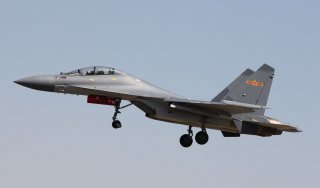No, China's J-16 Isn't a Stealth Fighter
State media exaggerates the fighter's radar-evading qualities
Chinese air force J-16 fighters are getting a new paint job that can reduce the type's radar signature. The state-run Global Times newspaper wrongly characterized the newly-painted J-16s as "near stealth."
That's inaccurate. Radar-absorbing paint can shrink a plane's signature, but not nearly enough to qualify the plane as stealthy.
The U.S. Air Force, the world's leading operator of stealth warplanes, acknowledges this fact. The USAF for decades has applied increasingly radar-absorbing paint to its F-16 fighters, but has never described the F-16s as stealthy.
The J-16 is an upgraded version of the older J-11 fighter that China copied from the Russian Su-27. In early 2019 the the People's Liberation Army Air Force possessed around 50 of the twin-engine, twin-tail fighters. More are in production.
The J-16 is a bridge between China's older fighters and its newer J-20 and J-31 stealth fighters. "These two new-generation jets would be too expensive to mass produce in the necessary numbers required to fully modernise the PLA Air Force’s combat fleet," Collin Koh, a researcher at Nanyang Technological University in Singapore, told the South China Morning Post. "Hence, the J-16 is crucial to bridge this gap."
New paint gives the J-16 modest stealth qualities. But state media exaggerated the degree to which a top coat can shrink a plane's radar cross-section.
On Jan. 29, 2019, Global Times paraphrased air force brigade commander Jiang Jiaji describing the J-16's new silver-gray paint as "a kind of cloaking coating that gives the warplane a certain stealth capability, making it nearly invisible to the naked eye and electromagnetic devices."
Radar-absorbing paint usually is composed of ferromagnetic particles embedded in a high-dielectric-constant polymer base. "The dielectric material slows down the [radar] wave and the ferromagnetic particles absorb the energy," aviation website Scramble explained.
The U.S. Air Force for decades has applied successive generations of ferromagnetic paint to its F-16s alongside indium-tin-oxide canopy coatings that also reduce the jet's signature. The latest, dark-gray Have Glass V paint job first appeared around 2012.
The American air arm slowly is applying the new paint to the roughly 200 F-16s it assigns to the dangerous suppression-of-enemy-air-defenses, or SEAD, mission. SEAD squadrons reside in Minnesota, South Carolina, Germany and Japan.
But no paint can compensate for a plane's shape. In particular, the shapes of its wings, engine inlet and engine nozzle. Square shapes, right angles and perpendicular planes such as engine turbines strongly reflect radar waves.
Even with Have Glass, the F-16 on average has a 1.2-square-meter radar cross-section, according to Globalsecurity, while the F-22 and F-35 boast RCSs smaller than .005 square meters. That explains why the Air Force never has described the F-16 as anything but a "fourth-generation" fighter, as opposed to a stealthy "fifth-generation" jet.
The original Su-27 has a whopping 15-square-meter RCS, Globalsecurity claimed. Substituting radar-absorbing materials for aluminum and other metals, as the Chinese apparently have done in producing the J-16, might shave a few percentage points off the type's RCS. Paint might further reduce the RCS.
But a RAM and paint can't turn a J-16 into a J-20 any more than Have Glass turned the F-16 into an F-22. The J-16 might be stealthier than an Su-27 is, but that doesn't mean it's a true stealth fighter.
All that is not to say the J-16 doesn't represent a significant upgrade of the PLAAF's combat capability. With superior range and payload compared to China's older J-10 and J-11 fighters, the J-16 could help to transform the PLAAF into an offensive air arm.
"In the past the PLA Air Force’s combat division has been characterised more as a defensive arm, with limited range and offensive capabilities, confined mainly to its immediate region and territory," Koh explained. "The J-16 will push the envelope further."
To make the best use of its J-16s, the PLAAF could borrow a page from the U.S. Air Force's own plans for combining fourth- and fifth-generation fighters. During wartime, stealthy J-20s could conduct initial strikes to suppress enemy defenses, clearing air space for non-stealthy J-16s safely to attack.
David Axe serves as the new Defense Editor of the National Interest. He is the author of the graphic novels War Fix, War Is Boring and Machete Squad.
Image: Chinese Internet.


